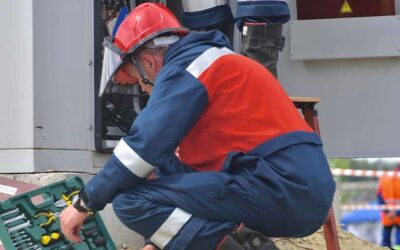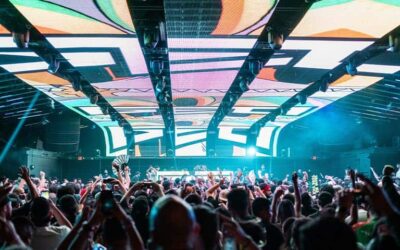When it comes to illuminating large areas, parking lots, or industrial areas, you may find yourself looped into the high-pressure sodium lights vs LED debate. However, our experts here at Action Services Group are ready to help make this decision easier by providing a clear explanation of the differences, costs, and quality of lighting provided by both systems.
Differences Between Low-Pressure Sodium, High-Pressure Sodium and LED Lights
Before we get to the real comparison, it is important to understand the types of lighting we are talking about. Sodium-based lights have been around for decades; in fact, the first sodium lights were commercially produced in 1932 and primarily used for streetlights and industrial areas. LEDs, on the other hand, were first marketed in the early 1990s for commercial and manufacturing purposes. With that being said, let’s take a look at what makes these lights physically different.
Low-Pressure Sodium Lights
Low-Pressure Sodium Vapor (LPS) lights are part of the High-Intensity Discharge (HID) family. As such, they utilize gas discharge to create light. LPS lights contain a solid sodium metal within an internal borosilicate glass tube. When the light is turned on, the sodium is heated and turns into a gas within this tube. During this state, the light will appear as a dim reddish or pink glow. However, as the metal becomes fully heated, it turns into vaporized emissions that create a bright yellow light. LPS lights remain yellow once fully lit. For the most part, LPS lights have become outdated and are not a competing factor when it comes to full illumination.
High-Pressure Sodium Lights
High-Pressure Sodium Vapor (HPS) lights, on the other hand, works to balance this intense yellow glow. As with the LPS variant, an HPS light is part of the HID family and works due to a gas discharge. Unlike the LPS variant, however, an HPS light uses a tube made of aluminum oxide. Additionally, the sodium metal is combined with other elements, such as mercury, to help reduce the yellow tint and give the light a slightly white to light blue hue instead.
Light-Emitting Diode Lights
Light-emitting diode (LED) lights do not work using gas discharge. In fact, LEDs are considered solid-state lights. Through the use of a semiconductor, the electric current supplied to an LED is converted to light. Unlike LPS and HPS lights, an LED does not require or emit heat; it is also one-directional, which means light is focused in a single direction without wasting energy or requiring reflection plates to redirect the light itself.
Did you know we have an entire section dedicated to Lighting and LED Product Education? We have interactive pages for Wall Packs, Post Tops, Parking and Area Lighting, High and Low Bay Lighting, and several more forms of Lighting Products.
Cost Savings in High-Pressure Sodium vs LED
As a business, there are two things you are most likely interested in: cost savings and quality. Before we discuss the differences in quality, let’s take a close look at how high-pressure sodium lights vs LED systems can affect your energy and maintenance costs.
Energy
When it comes to high-pressure sodium lights vs LED energy consumption, LED lighting has become the industry standard. Sodium-based lights require a warmup period. This can take up to 20 minutes in some cases, meaning your lights must be turned on at least 20 minutes prior to use to ensure maximum illumination. While this may not sound like much time when the lights remain on for hours, it all adds up.
If your HPS are used in lamps that illuminate a parking lot, it is likely these lights turn on within 20 to 30 minutes before nightfall to ensure full illumination. If you run your lights every night for a year, even just an extra 20 minutes a night means you have wasted money powering lights for roughly 122 additional hours annually. (That is a lot considering roughly 40% of your power bill is spent on lighting alone!)
LEDs, on the other hand, do not require any warmup time and reach full illumination as soon as they have been turned on. Furthermore, HPS lights are omnidirectional. They produce light in all directions, which must be redirected downwards to provide the brightest potential illumination. However, when redirected, lighting systems lose roughly 15% of their heat emissions, which equates to 15% of their illumination. This means 15% of the money spent on keeping HPS lights lit is wasted right from the very start. Because LEDs are one-directional, they do not suffer from this issue meaning you pay for exactly what you get.
Maintenance
HPS lights are considered to be one of the only light sources that even come close to the lifespan of an LED. In fact, HPS lights are expected to last up to 24,000 hours if left in an unadulterated state. (That means no bumping, vibrations, or other jolts that could damage them.) LEDs, by comparison, are expected to last between 50,000 and 100,000 hours. This means you will have to replace an HPS light twice for each LED you use based on lifespan alone. HPS lights are more fragile than LEDs. Not only does the sodium metal deplete faster than the diodes of an LED will, but the arc tube used within an HPS light is much more likely to shatter should they be bumped, dropped, or suffer from any type of vibration. LEDs, which do not have easily damaged internal components, are more likely to survive any of these types of jolts, thus requiring less replacing due to damages.
Light-emitting diodes are changing the commercial lighting maintenance landscape forever. For a closer look at maintenance savings, read our blog Saving Money with LED’s: Maintenance Expense.
Quality of Light
But, despite costs, the quality of your product is also important. Let’s take a look at how high-pressure sodium and LED lights compare when it comes to performance and illumination.
Performance
We have already pointed out that LEDs last twice as long, at a minimum, than an HPS light. So, when it comes to longevity, LEDs are already the clear winner. But how else to LEDs out-perform HPS lights? HPS lights typically contain traces of hazardous gases. Because they are fragile and operate through the use of gas and glass tubing, this makes these lights highly dangerous in environments where other hazardous or explosive materials are being used. Manufacturing companies, power plants, and even recycling centers, for example, would be ill-advised to use HPS lighting.
Lumens & Color Range
Lumens refer to the level of brightness your light is capable of. HPS lights are fairly efficient when it comes to lumens. In fact, they have been known to retain 80% of their lumens even at the end of their life. LEDs are roughly the same. When it comes to lumens per watt, both types of lighting are similar as well; LEDs often produce 37 to 120 lumens per watt. HPS lights are closer to a range between 40 and 150 lumens per watt. However, because of the omnidirectional issue HPS lights have, the perceived brightness is much less than that of an LED. Furthermore, LEDs come in a large range of colors. HPS, however, does not. In fact, while you can choose from almost any color range (2700K to 6000K on the color spectrum), HPS is limited to a yellow glow that stays around 2200K. This affects the level of illumination and can impact visibility.
Opt for LEDs with Action Services Group
When it comes to high-pressure sodium lights vs LED, the winner is clear. If you want the best bang for your buck, as well as the highest quality lighting, an LED retrofit is the right choice for you. If you want to learn more about sodium vs LED lighting, contact Action Services Group today by calling 610-558-9773, email [email protected] or schedule a call!







































Great content! Super high-quality! Keep it up! 🙂